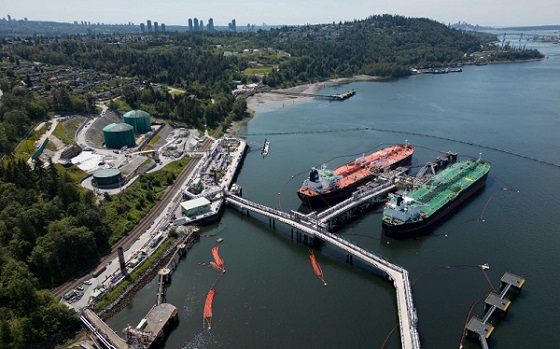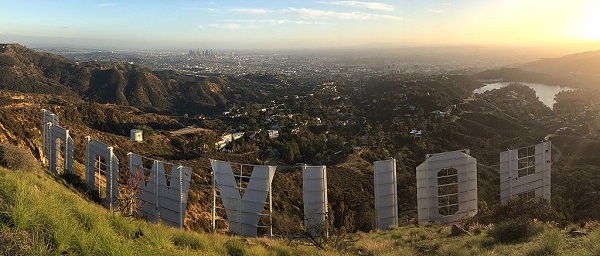International
Former Secret Service agents describe ‘apocalyptic security failure’ at Trump event

Police vehicles near the site of the Butler, Pa., venue where President Donald Trump was speaking when he was struck in the ear by a bullet in an assassination attempt
From The Center Square
Former U.S. Secret Service agents and security experts argue the Secret Service’s failure to prevent an assassination attempt against former President Donald Trump on Saturday was “apocalyptic,” exhibiting a “massive security breach.”
U.S. House Speaker Mike Johnson, R-Louisiana, has called for a congressional investigation. Multiple members of Congress are asking how a shooter ever reached a rooftop of a building to fire a shot at Trump, including U.S. Rep. Cory Mills, R-Florida, an Army veteran and counter sniper for the State Department who coordinated protective details for then Vice President Joe Biden, Condoleezza Rice and First Lady Laura Bush.
The assassination attempt on Trump was “a massive security breach,” Mills told CNN. The distance between the shooter and Trump was roughly 400 to 500 feet, “which is nothing for a shot adjacent to the stage of the president,” he said. “There was no one on that building, … in the building, standing next to the building to ensure there’s no access to the building,” he said. If there were, they “could have prevented this shooting.”
In an interview with Fox News, Mills said that the shots fired were the kind that soldiers learn in basic training boot camp and are “requested to make within nine weeks. This is one of the easiest shots.”
He said his job at the State Department involved working with an advanced team to establish a perimeter and “identify areas of threat that you would be able to mitigate … whether it be a building, … a lone tree … a parking lot. … Bottom line is this is massive negligence.”
Secret Service spokesperson Anthony Guglielmi has said agents responded quickly and the agency “added protective resources and technology and capabilities as part of [Trump’s] increased campaign travel.”
Former Secret Service agent Dan Bongino questioned this claim, asking on Fox News, “Which ones? You’re telling me the best technology you have was deployed and you missed a shooter 130 yards away … and even worse, it’s broad daylight on a white roof.”
He asked if there was forward-looking infrared deployed and if there was aerial support like drones and helicopters.
Bongino also pointed out that Trump “knew to duck … and saved his own life. That’s just a fact. The evacuation did not go right. The rule with the Secret Service is ‘cover the protectee’ and evacuate. The other rule is ‘maximum to the protectee, minimum to the problem. … Because you don’t know that’s the only problem. It could be a distraction. There could be another person in the crowd … you could be looking at multiple shooters.”
“The failure here is absolutely catastrophic,” he said, calling on Secret Service Director Kim Cheatle to resign immediately. He said Secret Service “absolutely resolutely 100% failed. This was an apocalyptic security failure. … An uneventful failure is never a success. The fact that Donald Trump didn’t die … is no reason for anybody to take some kind of victory lap.”
Former Secret Service agent Jeff James agreed, telling WTAE ABC News the agents on the stage should have moved Trump off sooner because the first shots fired “may have been the precursor in the real attack. There may have been four more gunmen who were going to start opening fire. I would have rather seen him get him into the armored cars and get him out of there more quickly.”
Bill Pickle, a former deputy assistant Secret Service director, told the Wall Street Journal, “The reality is there’s just no excuse for the Secret Service to be unable to provide sufficient resources to cover an open rooftop 100 yards away from the site. And there’s no way he should’ve got those shots off.”
Retired Secret Service agent Donald Mihalek called the failed assassination attempt “historic, drawing parallels to the 1912 shooting of Theodore Roosevelt in Milwaukee,” the Journal reported. “Roosevelt, then a former president who was running for a third term in the White House, was shot while heading to a campaign event. He survived the attempt on his life.”
Erik Prince, who previously provided diplomatic security services, said, “unaccountable bloated bureaucracies continue to fail us as Americans. Donald J. Trump is alive today solely due to a bad wind estimate by an evil would be assassin.”
Prince analyzed the wind at the time of the shot, arguing it was enough to displace the bullet two inches from Trump’s “intended forehead to his ear. DJT [Trump] was not saved by USSS [U.S. Secret Service] brilliance. The fact that USSS allowed a rifle armed shooter within 150 yards to a preplanned event is either malice or massive incompetence.
“Clearly there was adequate uncontrolled dead space for a shooter to move into position and take multiple aimed shots,” he said, adding that one counter sniper “was clearly overwhelmed as his face came off his rifle instead of doing his job to kill the shooter.”
A counter sniper killed the alleged shooter after he shot several rounds, wounding Trump, killing one, and critically wounding two others.
“In my old business of providing Diplomatic Security in two active war zones we were expected to execute the basics, or we would be fired,” Prince said. “Clearly USSS failed at the basics of a secure perimeter and once shots were fired, their extraction was clumsy and left DJT highly exposed to follow on attacks.”
He also expressed no confidence in anyone being held accountable, saying, “That’s not the Washington way. Unserious and unworthy people in positions of authority got us to this near disaster.”
Censorship Industrial Complex
Move over Soviet Russia: UK Police Make 10,000 Arrests Over “Offensive” Online Speech

In a nation where 90 percent of crimes go unsolved, the real emergency seems to be someone being offensive online.
|
|
Energy
Expanding Canadian energy production could help lower global emissions

From the Fraser Institute
By Annika Segelhorst and Elmira Aliakbari
Canada’s most timely opportunity to lower overall global emissions is through expanded exports to regions that rely on higher-emitting fuel sources.
The COP30 climate conference in Brazil is winding down, after more than a week of discussions about environmental policy and climate change. Domestic oil and natural gas production is frequently seen as a fundamental obstacle to Canada’s climate goals. Yet the data shows that Canadian energy production is already among the world’s cleanest, generating lower greenhouse gas (GHG) emissions per barrel-of-oil-equivalent produced, among major producing countries. Expanding the role of Canadian oil and gas in global markets can replace higher GHG-emitting alternatives around the world, driving down global GHG emissions.
Prime Minister Carney’s first budget highlights Canada’s “emissions advantage” in a chart on page 105 that compares the amount of GHG emissions released from producing oil and natural gas across 20 major producing countries. Compared to many other top-producing countries, Canada releases fewer GHG emissions per barrel of oil and gas produced when considering all phases of production (extraction, processing, transport, venting and flaring).
For oil production, Canada has an advantage over most major producers such as Venezuela, Libya, Iran, Algeria, Nigeria, China, Russia and Qatar. Canada’s emissions per barrel of oil produced are below the global average, making Canada among the lower emitting producers worldwide.
Similarly, Canada’s natural gas production has an emissions per barrel equivalent that is lower than the global average and is below major producers such as Turkmenistan, Uzbekistan, Nigeria, Indonesia, China, Argentina, Malaysia, Australia, Algeria, Iran, Russia, India and the United States. The chart below reveals countrywide average GHG emissions per barrel of oil or natural gas produced in 2022.
Source: International Energy Agency (2023), The Oil and Gas Industry in Net Zero Transitions 2023, IEA, Paris, p. 69
Canada’s emissions advantage stems from years of technological innovations that require less energy to produce each barrel of oil along with improvements in detecting leaks. From 1990 to 2023, Canada’s total production of crude oil rose by 199 per cent, while emissions per barrel of oil produced declined by 8 per cent, according to Environment and Climate Change Canada (ECCC). In the oilsands, since 1990 emissions per barrel have fallen by nearly 40 per cent while emissions from natural gas production and processing have decreased by 23 per cent.
Canada has already implemented many of the most practical and straightforward methods for reducing carbon emissions during oil and gas production, like mitigation of methane emissions. These low-hanging fruits, the easiest and most cost-effective ways to reduce emissions, have already been implemented. The remaining strategies to reduce GHG emissions for Canadian oil and gas production will be increasingly expensive and will take longer to implement. One such approach is carbon capture, utilization, and storage (CCUS), a technology which traps and stores carbon dioxide to prevent it from reaching the atmosphere. Major infrastructure projects like this offer potential but will be difficult, costly and resource intensive to implement.
Rather than focusing on increasingly expensive emission reductions at home, Canada’s most timely opportunity to lower overall global emissions is through expanded exports to regions that rely on higher-emitting fuel sources. Under a scenario of expanded Canadian production, countries that presently rely on oil and gas from higher-emitting producers can instead source energy from Canada, resulting in a net reduction in global emissions. Conversely, if Canada were to stagnate or even retreat from the world market for oil and gas, higher-emitting producers would increase exports to accommodate the gap, leading to higher overall emissions.
As Canada’s climate and energy policy continues to evolve, our attention should focus on global impact rather than solely on domestic emissions reductions. The highest environmental impact will come from enabling global consumption to shift towards lower-emitting Canadian sources.
-

 Alberta2 days ago
Alberta2 days agoAlberta to protect three pro-family laws by invoking notwithstanding clause
-

 Business2 days ago
Business2 days agoCanada is failing dismally at our climate goals. We’re also ruining our economy.
-

 Health1 day ago
Health1 day agoCDC’s Autism Reversal: Inside the Collapse of a 25‑Year Public Health Narrative
-

 Daily Caller1 day ago
Daily Caller1 day agoBREAKING: Globalist Climate Conference Bursts Into Flames
-

 Alberta2 days ago
Alberta2 days ago‘Weird and wonderful’ wells are boosting oil production in Alberta and Saskatchewan
-

 Health1 day ago
Health1 day agoBREAKING: CDC quietly rewrites its vaccine–autism guidance
-

 Crime1 day ago
Crime1 day agoCocaine, Manhunts, and Murder: Canadian Cartel Kingpin Prosecuted In US
-

 Energy1 day ago
Energy1 day agoHere’s what they don’t tell you about BC’s tanker ban













